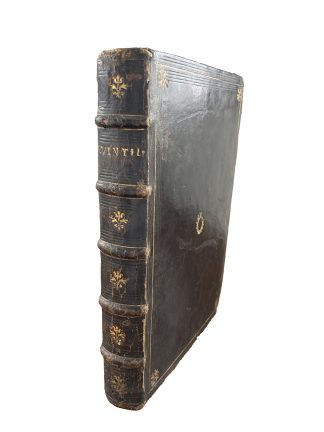QUINTILIAN.
FINE COPY
Institutionum Oratoriarum libri XII.
Venice, Aldus, 1521.£1,950.00
Large 8vo. ff. [4], 230. Italic letter, occasional Greek. Woodcut Aldine device to title and last verso, decorated initials and ornaments. Title and last verso a little dusty, repair to upper blank gutter of both, light water stain at blank foot of gathering c, another to upper blank gutter of first and outer upper blank corner of last couple of ll., little worm trail at blank foot of last 3 ll. A very good, tall, clean copy in c1840 crushed blue morocco, triple gilt ruled, gilt rosettes to corners, gilt Aldine device to covers, spine gilt, inner edges gilt, marbled eps, a.e.g., early ms ‘de innocentio doion’ to title and a1.
A very good, well-margined, clean copy of the second Aldine edition of Quintilian’s most influential manual of rhetoric. Edited by Naugerius and G.B. Ramusio, it includes a new table of Greek words, absent in the first. The text is modelled on that of the 1515 Giunta edition. Quintilian’s ‘Institutio Oratoria’ was the main text for the study of classical rhetoric until way into the C18 – ‘the most complete and detailed collection of the historical development of theories and techniques of communication in Greece and Rome up to the first century’ (Celentano, p.361). Written in the 1st century AD and rediscovered in 1416, it introduced students to the basic principles of rhetoric, e.g., orations, their elements, tropes and figures of speech. Issued without the editor’s preface, it begins with Quintilian’s own letter to his publisher, Trypho, who had allegedly been pressing him to finish his work – the result of 20 years of teaching – on the best education of the orator. The 12 books deal with preparatory material, the nature of rhetoric and its elements (inventio, dispositio, elocutio, memoria, actio), the character of the orator, and how he should study, prepare and argue his cases. ‘The Institutio has been described as four major works blended into one: a treatise on education, a manual of rhetoric, a reader’s guide to the best authors, and a handbook on the moral duties of the perfect orator’ (Murphy, p.59). Innocentio Doion was likely a member of the influential aristocratic Doglioni family, from Belluno. In 1625, he is recorded as one of the witnesses at the reading of the Bishop of Belluno’s will.
Renouard 154:1 (mentions 1522 title imprint, not present here); Ahmanson-Murphy 208 (attributed to 1522); EDIT16 CNCE 54149; Dibdin I, 335. M.S. Celentano, ‘Oratorical Exercises from the Rhetoric to Alexander to the Institutio oratoria’, Rhetorica, 29 (2011), pp.357–65; J. Murphy, ‘The Structure and Contents of the Institutio oratoria’, The Oxford Handbook to Quintilian (2021), pp.59-94; Archivio Veneto (1934), p.207.In stock






